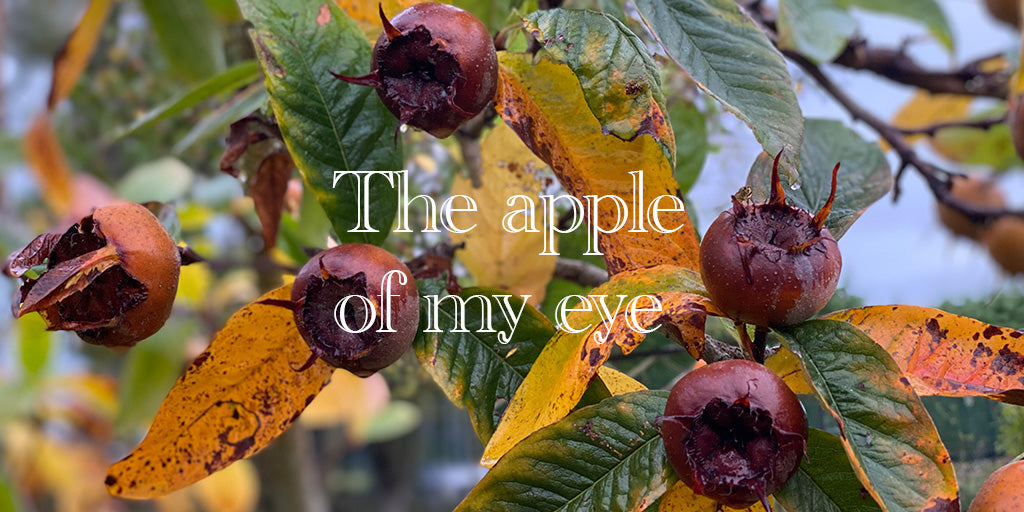My grandfather always loved his apple tree. It's exact location is a little hazy, I was only 6, but it stood at the end of the garden that backed onto Old Road that led down to the local factory where he once worked. The tree was a fabulous, well-kept shape and we used to climb it (or attempted to) under his watchful eye.
The garden has long gone, the original house replaced by an exact but modern replica, the council selling the land to build additional houses. I can't quite make out if the tree is still there, but every time I visit, I strain my neck to see.
Plum Tree Farm Orchard
One of the first things we did when we arrived at Plum Tree Farm was to attend an Orchard Management Course. We decided that we wanted to preserve and nurture the orchard, grow our own fruit, and enjoy the visual and physical space that an orchard offers. We wanted our orchard to be a productive part of our outdoor space as well as feeling like an extension of our garden.

Understanding what we had to do to achieve this and how we preserved, repaired and nurtured what was already there was important. As newcomers to our small community our neighbours thought we would build on the land or sell to a developer. I think they were relieved to find us with a plan to rejuvenate and map out a vision to plant for the future. Our limited knowledge can see that the main threats to many orchards has been and still is neglect and land development (there are many Orchard Close road signs) or using the land for alternative agricultural use. Our aim is to make sure none of these threats will face our small orchard in our lifetime.
We've loved the process of pruning. The idea of getting the space back in to shape and keeping the orchard healthy. February is the best time to tackle the apple trees: the plums we wait until summer. We have taken great pride in nurturing some of the oldies back to relative health and planting new to replace those that will eventually die.

We inherited a wonderful old walnut tree that had grown large and had rested two of its incredibly heavy boughs right through the middle of an old cider apple tree. How this supportive tree was still standing we were not quite sure. But after remedial work to both it now sports a very fashionable centre parting, its hollow trunk plays host to many insects and what we thought was a truly dead tree is after a little love and attention very much alive and manages to fruit every year.
One of the things I love about orchards is that they have probably occupied the same land for centuries, seen life come and go and with a bit of a manicure every now and again they have just quietly got on with their thing year after year.
With no chemical input the orchard has remained healthy. Sheep once grazed in the orchard until we bought the property. I'm sad to say we have driven them away. Their expert skill at the orchard coiffure, not to mention the no cost no effort replenishment of nutrients deposited back into the soil as they mow, is without question way better and easier than a mower. We currently have no barriers stopping sheep munching their way through our prize vegetables and flowers, nor our dog chasing the sheep... but we must put sheep and probably fences back on the list.
The space invites all manner of insects and wildlife, a hotspot for biodiversity and a natural refuge and habitat for wildlife from ladybirds to butterflies, bees, ants, mice, toads, an owl, bats and all those wonderful creatures the naked eye cant see. In the far corner of the orchard our compost bins are home to snakes and maybe mice or something perhaps larger. Badgers pass through but we haven't seen hedgehogs, as hard as we have tried to attract them.

The aforesaid giant of a walnut tree pretty much takes centre stage. Squirrels are very adept at fleecing the tree of its wares before we have even thought of harvesting the walnuts ourselves. One year I'm determined to beat them at their game as I want to try my uncles incredible Walnut Liqueur recipe. Only once tried on a visit to his home in Southern Australia, but never forgotten!
In late spring the blossom blooms on the fruit trees and surrounds this majestic walnut structure with a pretty white and pink haze. As the fruit starts to form over the summer months I start to plan what delicious store cupboard delights we will produce after harvest in Autumn. We have apples (cookers, eaters, cider and a medlar) and of course a plum; a gift from my parents when we moved in. We were going to plant pears this year in March, but life has been busy, and we may have missed our chance. Cherry trees will follow, but perhaps more ornamental than productive.
In September and October the apple trees are laden with fruit. Some, like our cooker looking very much like a Christmas tree weighed down with heavy decorative baubles, the boughs bent with fruit forcing the branches to droop and almost break. And as we try to keep up with harvesting, some fruits fall and start to take on that sweet smell, the beginning of decay under the munching gorging jaws of slugs and wasps.
We've yet to sow wild flowers, a plan in progress, but in October we have lots of fungi growing in patches across the orchard floor - some edible some not. Our fair share of mistletoe hangs from the trees in its full glory in December just in time for Christmas.
An enormous pile of wood rests against an old stone barn from what was once a dense black wall of 32 enormous Leylandii, once providing a nice wind break from a brisk south westerly, but blocking out all the sun from the orchard. These have now been replaced by a newly laid native hedge that incorporates a selection of old trees that grew in all directions and angles under the dark Leylandii canopy. Once in search of light they now thrive in open sunshine.
The start of this journey has been inspiring and a wonderful sense of achievement. The orchard is a calm and contemplative place. A haven of solitude. A very special place.


